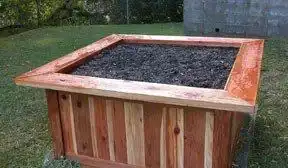Raised Bed Frames What to Use and Why
Having built many raised bed frames for schools, and private and semi-commercial (sell your excess produce to others) organizations, I have developed a list of criteria for the most satisfactory raised bed.


Raised Bed Frames Criteria
I have tried various heights for raised beds and found, depending upon the size of the gardener, about 30 inches is best.
Growing plants is not too different from growing humans. The better the food sources, the taller, healthier, and more robust people are. The poorer the food sources, the smaller, weaker, and more prone to diseases people are.
What I want in raised bed frames
- Fairly easy to build
- Familiar materials
- Durability is not a significant issue. Someone will probably have developed something better by the time it rots away.
- I want to sit on the edge of the raised bed to plant, harvest, and remove dying or corrupt plants.
- Bed width is four feet or less. It will be easy to reach even the center of the bed. Long periods of planting may create a stiff back when bending over.
- Relatively strong to support your body weight and rigging for nets, sunscreen, frost coverings, etc.
- Must be stable in windy conditions
- Bed height is at a comfortable height to work.
- Irrigation system
- Easy to work on from at least three sides
- Preferably no toxins or chemicals in the materials
- Fasteners/Connection devices need to be very durable.
- Easy to attach framing for netting, sunscreen
I have built them from wood to plastics to concrete blocks. Each type of raised bed has its benefits and weakness. Your experience may vary. Various online sites have videos demonstrating raised-bed construction. Check them out to see some raised-bed systems.
Raised Bed Frames with Wood
- Expensive compared to concrete blocks
- Lightweight
- Easy to handle
- It comes in various kinds/types, thicknesses and lengths, and durability.
- Easy to change
- Ease of transportation
- Familiar working material
- Deteriorates at various rates depending on the material
- Elevation-dependent upon construction skill level
- Easy to attach frames for netting, sunscreen, and frost protection
- It can contain contaminants and toxins.
- Easy to build
- Can stain the bed’s exterior wood with to color (need to consider toxins when choosing the stain) coordinate garden area
Raised Bed Frames with Concrete Blocks
- It comes in standard lengths.
- It does not deteriorate over time.
- The weight of blocks is an issue.
- Easy to transport
- Easy to attach netting, sunscreens, to a degree frost protect
- It can come in colors.
- It can be challenging to work with
- Contains few contaminants
- Building more than two courses without adhesive (non-toxic glue, mortar) is difficult.
- Easy to add frames for bird netting, sunscreens, and frost protection
- I have created a video on how to build a concrete block-raised bed.
- Visually not too appealing
Raised Bed Frames with Plastic Wood
- Expensive compared to concrete blocks and wood
- Lightweight
- Easy to handle
- It comes in various kinds/types, thicknesses and lengths, and durability.
- Modifications to design
- Easy of transportation
- Can attach netting, sunscreens, to a degree frost protect
- Material deterioration depends on the material. Some manufacturers claim 40 or more years.
- Elevation-dependent upon construction skill level
- Plastic wood health issues are unclear. However, the industry proclaims safe for garden use.
- Easy as wood to build
- Small choice of colors
Raised Bed Frames with Straw Bales
- Inexpensive
- Easy to build
- Fairly easy to handle
- It doesn’t last long (about two years)
- It is not readily adaptable.
- An excellent insulator to keep the heat in the bed
- It is not easy to attach netting or sunscreens.
- Little aesthetic appeal
- Attracts insects and rodents
Which Raised Bed Frames do I prefer?
I find wood to be the best material to build a raised bed. I have removed the wood rot problem from water through our color wood treatment and UV protection system. Wood is inexpensive, easy to work with, and comes in standard shapes and lengths. I can change the shape and size at will without it being expensive.
Concrete blocks are my second favorite building material. They create a raised bed that can withstand weed-whacker attacks. The blocks are easy to work with and allow for many structure variations. They can support a frame for sunscreen and bird netting. They warm with the sun faster than wood. Concrete won’t deteriorate as wood. You can change the appearance of concrete blocks using stucco on the bed’s outside surface. Colorful decorations on the sides will make it appealing. The use of concrete can overcome some construction issues.
What kind of Raised Bed Frames do I not prefer?
I don’t believe building raised bed frames from plastic wood is beneficial. We don’t have a good track record of creating synthetic materials that DO NOT pollute our environment. After all, the purpose of an organic raised bed is not to incorporate inorganic materials. I find it challenging to believe plastic wood’s chemical composition will not leach into the growing medium.
Straw Bales
Straw bales don’t last very long and look unappealing. In addition, they do not lend themselves to change or keep pests out of the garden.
I hope this helps you find, construct, and use your raised bed frames.
